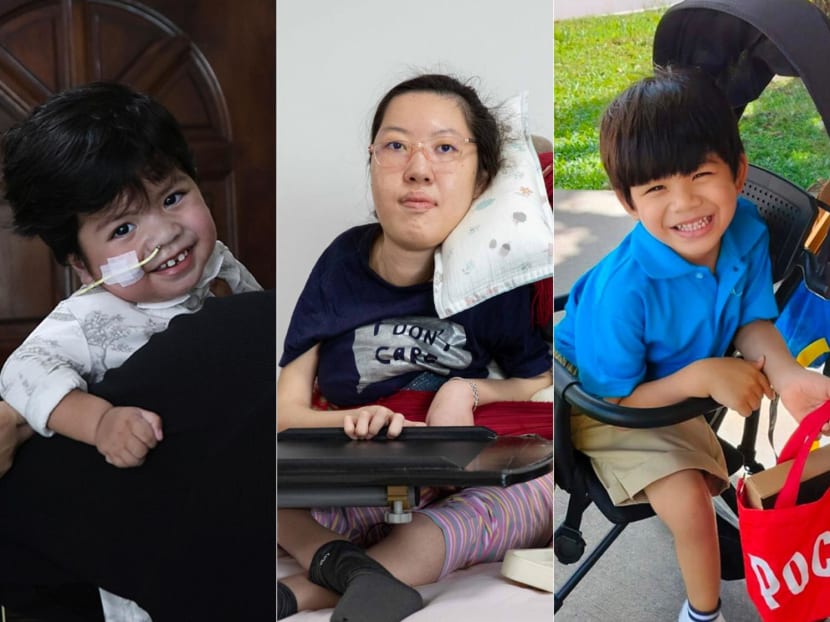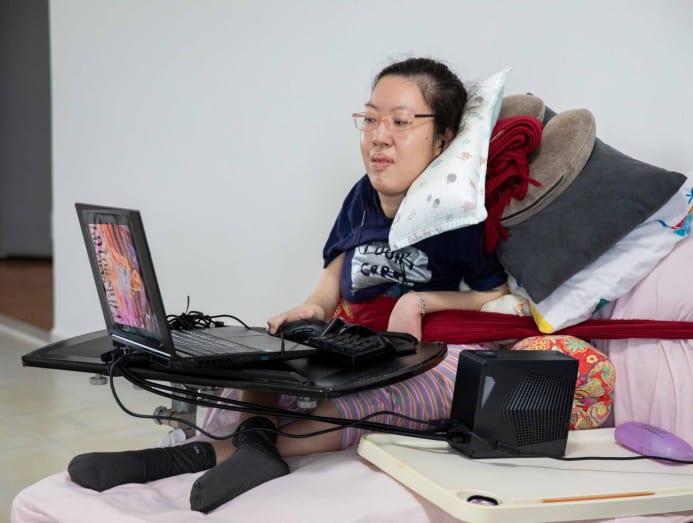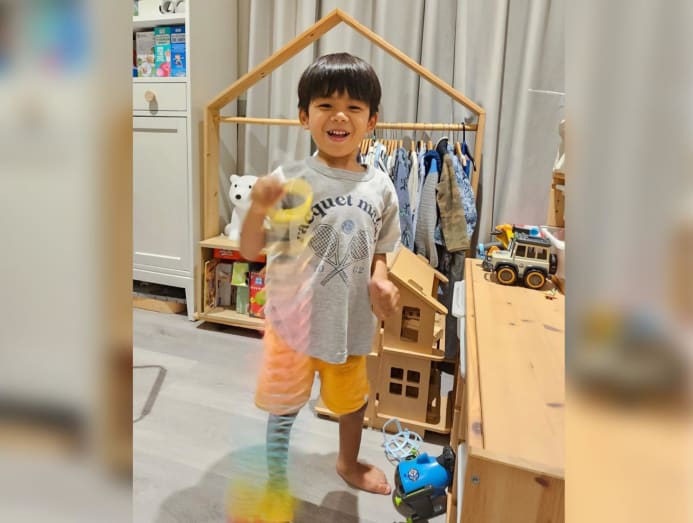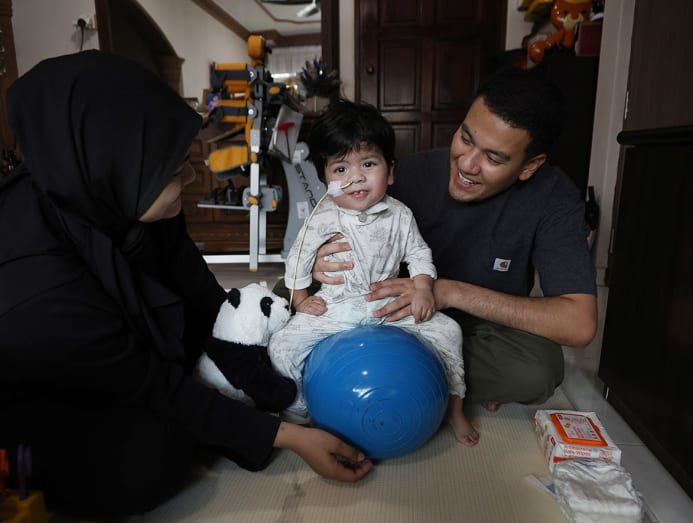Living with spinal muscular atrophy: Patients pay millions for drugs or face rapid decline in quality of life

(From left) Spinal muscular atrophy patients Zayn Nabeel Abdat, Sherry Toh and Devdan Devaraj.
SINGAPORE — Drinking a glass of water is an act that most people do not give a second thought to, but for 25-year-old Sherry Toh, it is a task that takes her exactly 52 seconds to complete.
Since she was diagnosed with Type 2 spinal muscular atrophy (SMA) as an infant at 13 months old, she has struggled with even the simplest tasks because the congenital neuromuscular disorder, which is characterised by the loss of motor neurons, leads to muscle weakness and atrophy.
Most patients are unable to stand or sit unsupported, and as the disease worsens, they have problems swallowing, speaking and breathing. Ms Toh, who spends most of her time on the sofa, needs cushions to prop up her head and back.
She found some respite recently through the drug Evrysdi.
Apart from no longer being out of breath when speaking or getting through daily tasks such as typing, she took just 16 seconds to finish that cup of water — almost the same speed as an average adult.
This marked improvement in her condition, however, was short-lived.
When her crowdfunding campaign to pay for the costly drug did not hit its target of S$375,000 to pay for a year’s supply, the drug’s manufacturer Roche donated a three-month supply to her in May last year.
She took her last dose of the drug in September last year.
“I’m very out of breath when I drink water now,” she said of one of her many struggles.
Her crowdfunding campaign is still up more than a year later but has raised just S$89,425 — 23 per cent of her goal.
Her doctor can only prescribe her the drug when she can pay for at least half a year’s supply of the drug.
Research has shown that patients only show improvement after six months of taking the drug.
Ms Toh said that she does not want whatever money she has raised to go to waste and if she does not meet the target, she will donate it to another SMA patient.
SMA is a rare disease with 40 to 50 people suffering from it here.
The condition made headlines in the last few years due to several crowdfunding campaigns to bring in Zolgensma — one of the world’s most expensive drugs — to help at least four babies diagnosed with the condition.
There is no cure, but there are treatments that can improve patients’ quality of life and the Health Sciences Authority now approves the use of Spinraza, Evrysdi, and the gene therapy Zolgensma, although these drugs are not subsidised.
Zolgensma, which was approved by the United States Food and Drug Administration in 2019, is a one-time therapy that must be administered before the patient turns two years old.
In Singapore, it costs S$2.4 million and must be paid up in full before administration.
Prices vary globally, generally around S$2.7 million to S$2.8 million in the US and Europe, but in Australia, the treatment is fully covered under the Pharmaceutical Benefits Scheme.
For Evrysdi, an oral medication taken daily to increase the production of a protein that SMA patients lack, it costs about S$375,000 for a year's supply.
Spinraza, which needs to be administered directly into the cerebrospinal fluid and requires a hospital stay, costs between S$845,480 and S$1.1 million for four injections in the first year and then S$507,000 for three doses in subsequent years.
There is some hope for sufferers, though, with the Agency for Care Effectiveness on June 4 recommending that the Medication Assistance Fund subsidise drugs such as Evrysdi from Aug 1.
The agency, which was set up by the Ministry of Health (MOH), is the national health technology assessment and clinical guidance agency.
Following the agency's recommendations, MOH will review the matter. TODAY has reached out to the ministry to find out whether Evrysdi will be subsidised from August.
Until that happens, Ms Toh wants to continue finding ways to fund her medication, adding that she has “many dreams she wants to accomplish.”
Recently, her work as a video games journalist earned her a coveted spot at the Game Awards’ Future Class programme last year, which recognises leaders in the video game industry.
Those selected will have opportunities for networking, career development and will get to attend workshops and panels.
The programme picks just 50 applicants out of thousands every year, and Ms Toh is the sole Singaporean participant this year.
She hopes to work in video game development and create a game that can help others feel like they are seen for more than their disabilities.
“There are still options. There is hope and a way to stall the progression of your disability, and even to reverse some of the effects, you still have options. There are still things to do and live for," she said.
Even though she is relieved that families with babies who have SMA were able to receive the donations they needed, Ms Toh feels “left behind”.
“I don’t know if it’s that people just haven’t heard my story or if it’s got something to do with the fact that babies are cuter,” she said of the inability to raise money for her condition.

LIFE AFTER FUNDRAISING FOR THE ‘MIRACLE DRUG’
Even though fundraising was a “nerve-racking” experience, parents of children with SMA told TODAY that seeing how well their children have responded to these expensive medications made it worth their while.
The treatment is not a cure for the condition, but it has given patients a better quality of life, allowing them to lead a close to “normal” life.
For example, before receiving the gene therapy, Ms Shuwen Devaraj's son Devdan, who was diagnosed with Type 2 SMA at seven months old, found it difficult to feed himself, she said.
He had to constantly lower his head to his spoon since he did not have enough strength in his arms to lift the spoon to his mouth and had hand tremors.
Ms Devaraj said that five-year-old Devdan is now “getting really strong”. From not being able to lift the spoon to his mouth, he can now wheel himself around in a wheelchair.
“He’s growing up like a normal child; he’s just weak in walking, but he has gained some independence,” she added.
She remembered the trepidation she felt after doctors from National University Hospital told her it would cost S$2.9 million for him to get Zolgensma.
This amount seemed staggering for the interior designer and her civil service husband, both 36, to come up with on their own.
She had heard of other fundraising bids that did not raise enough money or were met with scepticism by the public where some donors insisted on getting their donations back.
Still, she knew that she had to try because Zolgensma had been dubbed the “miracle drug” for young patients of SMA.
She contacted the online fundraising platform Ray of Hope as a last-ditch effort because Devdan was already nearing his second birthday.
“I probably didn’t sleep for those ten days,” Ms Devara said. “I didn’t know there were so many kind people in this world. I think it has changed me and changed my life.”
After a crowdfunding campaign that raised S$2.87 million in 10 days, Devdan received Zolgensma in September 2021.
While the boy will not require any long-term medication, he attends physiotherapy sessions at a private clinic, which costs about S$240 an hour. During the first two years of receiving Zolgensma, Devdan attended these sessions a few times a week to build his strength.
His parents said that they had to reduce their household expenses to pay for his physiotherapy sessions.

EVERY IMPROVEMENT A CELEBRATION
Data centre specialist Nabeel Abdat, 32, and homemaker Syahirah Yakub, 33, similarly had to raise money for their son Zayn to receive Zolgensma.
Zayn was diagnosed with SMA Type 1, the most severe form of the disorder, when he was barely a month old.
“It was a tough journey because we started in mid-August (in 2022), and we only got the funds about October, and the medication only came in about late November that year,” Mr Nabeel said.
“Every day was nerve-racking because we explored every possible means to get the word out there."
The couple’s donations plateaued at around S$1.5 million, leading them to make posters to place at churches, temples and mosques.“We were very desperate,” Ms Syahirah said, adding that at the time, they were overextending on their credit cards to pay S$15,000 for a bottle of Evrysdi because Zayn’s condition deteriorated while they were fundraising.
“We were just thinking, what would happen if this were to happen to someone who just doesn’t have that kind of money?” Ms Syahirah asked.
“It’s quite critical. Every minute is ticking, so we need the drugs as soon as possible.”
Ms Syahirah suggested that if there was some kind of government subsidy, it would not leave parents in this situation “hanging”.
“The doctor predicted that Zayn can’t even sit on his own and only make minimal movements. But now, he can sit on his own for five minutes and he’s also learning how to walk and stand on his own.”

These improvements have renewed hope in Mr Nabeel and Ms Syahirah that their son may lead a more independent life that many children who have SMA Type 1 without treatment might not be able to do.
They are looking forward to one day taking him overseas for a holiday.
“At this stage, Zayn is like in between a Type 1 and Type 2 (for SMA) because he’s able to sit down where most type 1 patients are not able to,” Mr Nabeel said.
“We’re not expecting him to run, but at least when he’s in the wheelchair, he can still stand up and have a few walks to maybe go to the toilet, that kind of thing.”
With Zolgensma, his breathing has also improved — Zayn can now spend about 90 minutes off his ventilator a couple of times each day, compared to being on the ventilator constantly.
“It’s like a small celebration for us,” Ms Syahirah said.









